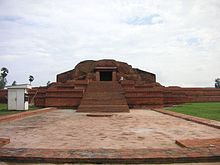The Pāla Empire (Bengali: পাল সাম্রাজ্য Pal Samrajyô) was an Indian imperial power, during the Classical period of India, that existed from 750–1174 CE. According to Abu’l-Fazl ibn Mubarak (in Ain-i-Akbari), the Palas were Kayasthas. It was ruled by a Buddhist and Hindu dynasty from Bengal in the eastern region of the Indian subcontinent, all the rulers bearing names ending with the suffix Pala (Modern Bengali: পাল pāl), which means protector. The Palas were often described by opponents as the Lords of Gauda. The Palas were followers of the Mahayana and Tantric schools of Buddhism. Gopala was the first ruler from the dynasty. He came to power in 750 in Gaur after being elected by the various regional chieftains.[1] He reigned from 750–770 and consolidated his position by extending his control over all of Bengal. The dynasty lasted for four centuries (750–1120 CE) and ushered in a period of stability and prosperity in Bengal. They created many temples and works of art as well as supported the Universities of Nalanda and Vikramashila. Somapura Mahavihara built by Dharmapala is the greatest Buddhist Vihara in the Indian Subcontinent.
The empire reached its peak under Dharmapala and Devapala. Dharmapala directly ruled the present-day Bihar and Bengal regions, and also subdued kings of North India. His successor Devapala captured Kamarupa (present-day Assam) and Utkala (present-day Orissa). He also subduded the Gurjara-Pratiharas and the Rashtrakutas. The Pala inscriptions also credit him with other victories, which are exaggerated (see the Extent section below).
The death of Devapala ended the period of ascendancy of the Pala Empire and several independent dynasties and kingdoms emerged during this time. However, Mahipala I rejuvenated the reign of the Palas. He recovered control over all of Bengal and expanded the empire. He survived the invasions of Rajendra Chola and the Chalukyas. After Mahipala I the Pala dynasty again saw its decline until Ramapala, the last great ruler of the dynasty, managed to retrieve the position of the dynasty to some extent. He crushed the Varendra rebellion and extended his empire farther to Kamarupa, Odisha and Northern India.
The Pala Empire can be considered as the golden era of Bengal.[citation needed] Palas saw the rise of tantra and Vajrayana buddhism and were responsible for the introduction of Mahayana Buddhism in Tibet, Bhutan and Myanmar . The Palas had extensive trade as well as influence in south-east Asia. This can be seen in the sculptures and architectural style of the Sailendra Empire (present-day Malaya, Java, Sumatra). The empire gradually disintegrated by the 12th-century after the death of Ramapala, meeting its final end in the defeat of Govindapala, the last Pala king, by Ballal Sena of the Sena dynasty in 1174.[2]
The origin of the Palas is not clearly stated in any of the numerous Pala records.
The Ramacharitam of Sandhyakar Nandi attests that Varendra (or North Bengal) was the fatherland (Janakabhu) of the Palas. In the Bangarh Copperplate inscription of Mahipala I, it has been stated that Mahipala recovered his ancestral homeland (Rajyam Pitram) from the usurpers (which was until that time occupied by the Kamboja-Pala Kingdom).
The Khalimpur copper plate inscription of Dharmapala, the second Pala emperor, states that Gopala I was a son of a warrior (Khanditarat) named Vapyata, grandson of a highly educated man (Saryavidyavadat) named Dayitavishnu.
The Kamauli copper plate inscription of king Vaidyadeva of Kamarupa (Assam) connects the Palas to the Kshatriyas of “Mihirasya vamsa” (Surya lineage).[3][4][5][6][7][8]
The Ballala-Carita says that “The Palas were Kshatriyas“, a claim reiterated by the historian Taranatha in his “History of Buddhism in India” as well as Ghanaram Chakrabarty in his Dharmamangala (both written in the 16th century CE). The Ramacharitam also attests the fifteenth Pala emperor, Ramapala, as a Kshatriya. As Gopala I was a Buddhist, he was also branded as a Śudra king in some sources.[9][10][11][12][13]
According to Abu’l-Fazl ibn Mubarak (in Ain-i-Akbari), the Palas were Kayasthas. There are even accounts that claim Gopala may have been from a Brahmin lineag
After Shashanka‘s reign, Bengal was shrouded in obscurity and was shattered by repeated invasions. During the reign of Manava, Bengal was invaded and divided between Harshavardhana andBhaskaravarman. In 730 CE Jayavardhana of the Shaila Dynasty from Central India invaded Bengal and killed the king of Pundravardhana. Yasovarman (725–752) of Kannauj killed the king of Magadhaand Gauda. Later Lalitaditya Muktapida (724–760) of Kashmir who defeated Yasovarmana invaded Bengal. Sri Harsha of Kamarupa conquered Anga, Vanga, Kalinga and Odra. The social and political structure of Bengal was disturbed, resulting in a condition described as Matsyanyaya (“eating of small fish by the big fish”).
Gopala ascended the throne as the first Pala king during these times. A copper plate from the reign of the second Pala King Dharmapal suggests that the prakriti (people) of the region made him the king.[15] The Tibetan Buddhist lama Taranatha (1575–1634), writing nearly 800 years later, also writes that he was democratically elected by the people of Bengal. However, his account is in form of a legend, and is considered historically unreliable. The legend mentions that after a period of anarchy, the people elected several kings in succession, all of whom were consumed by the Naga queen of an earlier king on the night following their election. Gopal, however managed to kill the queen and remained on the throne.[16] The historical evidence indicates that Gopala was not elected directly by his citizens, but by a group of feudal chieftains. Such elections were quite common in contemporary tribal societies of the region.[16][15]
Gopala’s ascendancy ended the period of anarchy.
